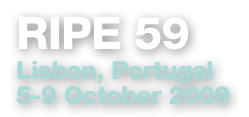DNS Working Group
Dates: Thursday, 8 October, 11:00-12:30 | Thursday, 8 October, 14:00-15:30
Thursday 11:00-12:30 • Morning Session
A. Administrative Matters - 2'
- Welcome
- Select scribe
- Jabber
- Finalise agenda
B. Matters arising from RIPE 58 Minutes - 3'
C. Review of Action Items - 10'
D. IETF Report - Carsten Strotmann, Men and Mice - 10'
E. ITAR Update - Dave Knight, ICANN - 10'
Progress report on the ITAR.
F. DNSwitness: Recent Developments - Stephane Bortzmeyer, AFNIC - 15'
DNSwitness is a set of (free software) programs to gather statistics
from the DNS. The active component of DNSwitness now has more data to display, showing an increase in IPv6 use in .FR. The new passive component allows us to get information from the packets we receive.
G. Provisioning DNSSEC - What Would Operators Do? - Ed Lewis, Neustar - 15'
Recent lapses in the operation of Trust Anchor Repositories illustrate the need to develop some operationally sound means to exchange
DNSSEC Keys amongst operators of DNS servers; both from the operator
of a zone upwards (e.g., a TLD) and, if needed, to ISP-run caches. This talk discusses the operational considerations and opens the floor to suggestions for requirements.
H. Follow-up to EOF Presentations - 20'
Discussion about root signing, DNSSEC in .pt
Thursday 14:00-15:30 • Afternoon Session
I. RIPE NCC Update - Anand Buddhev, RIPE NCC - 10'
J. Lame Delegation Analysis for the RIPE Region - Shane Kerr, ISC - 25'
Falling Trees (or If a DNS Server is Lame but Nobody Queries It, Should I Get an Email?) Queries to the RIPE NCC server for reverse DNS were recorded and compared against which name servers are lame. Based on this, we can see which queries are affected by lameness, and how badly.
K. ICANN/OARC Root Zone Augmentation Impact Analysis - Duane Wessels, OARC - 15'
ICANN commissioned DNS-OARC to study upcoming changes to the DNS root zone. In particular, we examined signing the zone with DNSSEC, increasing the number of TLDs, and adding more IPv6 glue records. OARC studied how these changes affect zone size, response latency, start and reload times, AXFR and IXFR bandwidth requirements, and potential increases in queries over TCP.
L. Root Zone Scaling Survey Findings - Lyman Chapin, Interisle - 15'
M. Open Discussion on Root Scaling - 20'
Z. AOB
Presentations
Here are the presentations as uploaded by presenters. After the meeting ends, we will convert these files to PDF and post online.
Warning: file_get_contents(uploads/html/Thursday/DNS WG 11:00/index.html): failed to open stream: No such file or directory in /var/www/html/ripe-59/content/agendas/dns.html on line 61
Presentations for the DNS session 11:00 will be available here as soon as presenters upload it.
Warning: file_get_contents(uploads/html/Thursday/DNS WG 14:00/index.html): failed to open stream: No such file or directory in /var/www/html/ripe-59/content/agendas/dns.html on line 78
Presentations for the DNS session 14:00 will be available here as soon as presenters upload it.


